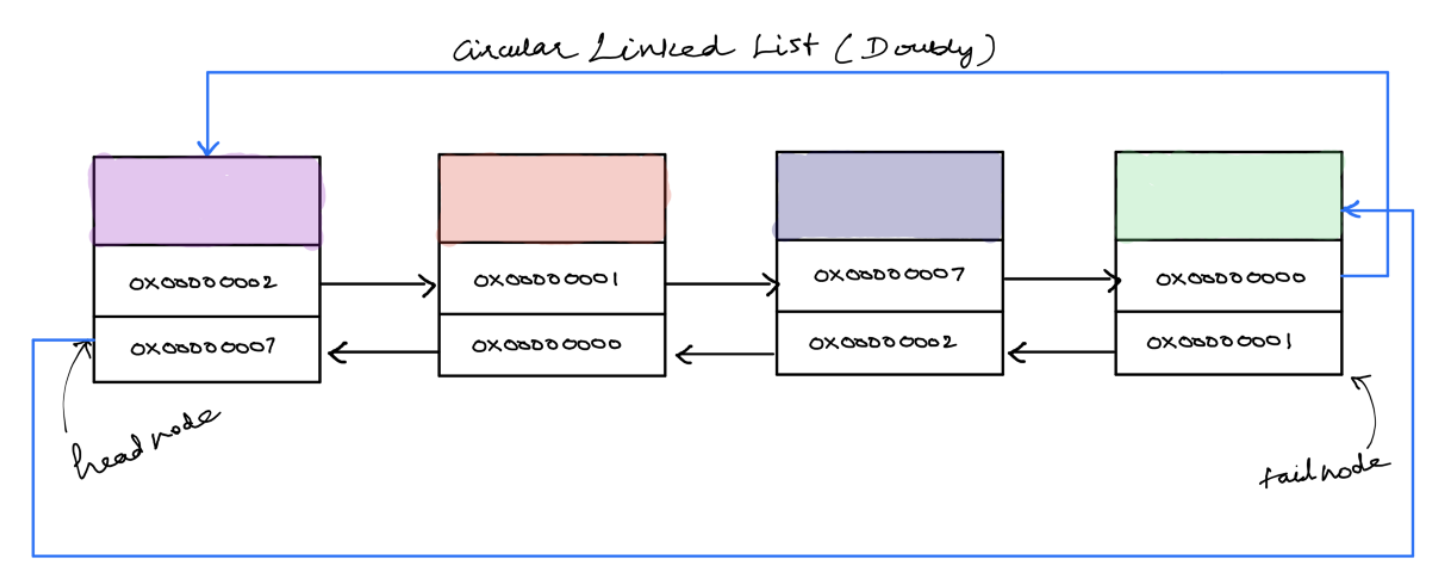
本篇文章将会使用链表实现一个简易音乐播放器。其中,涉及到的知识有三种链表的构造,链表的操作。
三种链表:
链表的操作:


首先实现一个单链表的音乐播放器。它有两个函数 create_playlist 和 show_playlist 组成。其中,create_playlist 用于构建音乐播放器,它实际实现的是链表的插入操作。show_playlist 用于单向查找音乐在将其显示出来,它实际实现的是链表的查找操作。
package main
import "fmt"
var init_head head
type head struct {
next *song
}
type song struct {
name string
artist string
next *song
}
func create_playlist(head_pointer *head, current_song *song) {
if head_pointer.next != nil {
tmp := head_pointer.next
for tmp.next != nil {
tmp = tmp.next
}
tmp.next = current_song
} else {
head_pointer.next = current_song
}
}
func show_playlist(playlist *head) {
if playlist.next != nil {
for tmp := playlist.next; tmp != nil; tmp = tmp.next {
fmt.Printf("playing %s by %s\n", tmp.name, tmp.artist)
}
} else {
fmt.Printf("It is an empty playlist")
}
}
func main() {
create_playlist(&init_head, &song{name: "理想三旬", artist: "陈鸿宇"})
create_playlist(&init_head, &song{name: "蓝莲花", artist: "许巍"})
create_playlist(&init_head, &song{name: "乱舞春秋", artist: "周杰伦"})
create_playlist(&init_head, &song{name: "稻香", artist: "周杰伦"})
create_playlist(&init_head, &song{name: "和你在一起", artist: "李志"})
show_playlist(&init_head)
}
这里使用了 head 结构体作为结点的头指针,使用全局变量 init_head 保存头指针的地址,在创建和 show playlist 时需要将头指针作为参数传递给函数。
从上述示例中可以看出:

单链表播放器只能单向查找,单向插入,实现音乐的下一首功能而无法实现上一首功能。基于此,这里使用双链表进行重新改造,并且使用方法而不是函数来实现音乐播放器的添加和显示功能。
package main
import (
"fmt"
"strings"
)
var current_song string
type playlist struct {
next *song
tail *song
}
type song struct {
name string
artist string
next *song
previous *song
}
func player_song() {
fmt.Printf("play song: ")
fmt.Scanln(¤t_song)
}
func (player *playlist) add_song(name string, artist string) {
current_song := &song{name: name, artist: artist}
if player.next != nil {
player.tail.next = current_song
player.tail.next.previous = player.tail
player.tail = current_song
} else {
player.next = current_song
player.tail = current_song
}
}
func (player *playlist) next_song() {
if current_song == "" {
fmt.Printf("The current song is empty, please playing a song first.\n")
player_song()
}
if player.next != nil {
tmp := player.next
for tmp != nil {
if strings.EqualFold(tmp.name, current_song) {
if tmp.next != nil {
fmt.Printf("the current song is %s by %s\n", tmp.name, tmp.artist)
fmt.Printf("the next song is %s by %s\n", tmp.next.name, tmp.next.artist)
current_song = tmp.next.name
break
} else {
fmt.Printf("this is the last song.")
break
}
}
tmp = tmp.next
}
if tmp == nil {
fmt.Printf("the song %s is not in the playlist\n", current_song)
}
} else {
fmt.Printf("It is a empty playlist\n")
}
}
func (player *playlist) previous_song() {
if current_song == "" {
fmt.Printf("The current song is empty, please playing a song first.\n")
player_song()
}
if player.tail != nil {
tmp := player.tail
for tmp != nil {
if strings.EqualFold(tmp.name, current_song) {
if tmp.previous != nil {
fmt.Printf("the current song is %s by %s\n", tmp.name, tmp.artist)
fmt.Printf("the previous song is %s by %s\n", tmp.previous.name, tmp.previous.artist)
current_song = tmp.previous.name
break
} else {
fmt.Printf("this is the first song.\n")
break
}
}
tmp = tmp.previous
}
if tmp == nil {
fmt.Printf("the song %s is not in the playlist\n", current_song)
}
} else {
fmt.Printf("It is a empty playlist\n")
}
}
func (player *playlist) show_playlist_reverse() {
if player.tail != nil {
tmp := player.tail
for tmp != nil {
fmt.Printf("playing %s by %s\n", tmp.name, tmp.artist)
tmp = tmp.previous
}
fmt.Printf("\n")
} else {
fmt.Printf("It is a empty playlist\n")
}
}
func (player *playlist) show_playlist() {
if player.next != nil {
for tmp := player.next; tmp != nil; tmp = tmp.next {
fmt.Printf("Playing %s by %s\n", tmp.name, tmp.artist)
}
fmt.Printf("\n")
} else {
fmt.Printf("It is a empty playlist\n")
}
}
func main() {
album := playlist{}
album.add_song("理想三旬", "陈鸿宇")
album.add_song("蓝莲花", "许巍")
album.add_song("乱舞春秋", "周杰伦")
album.add_song("稻香", "周杰伦")
album.add_song("和你在一起", "李志")
album.show_playlist_reverse()
album.show_playlist()
album.next_song()
album.previous_song()
album.previous_song()
album.next_song()
album.next_song()
}
这里使用结构体 playlist 存储指向节点 song 的头指针和尾指针,通过 playlist 即可实现节点的插入,查找操作。并且,使用一个全局变量 current_song 来存储当前播放的音乐,用户可以手动输入当前音乐然后实现上一首,下一首播放效果。执行结果:
playing 和你在一起 by 李志
playing 稻香 by 周杰伦
playing 乱舞春秋 by 周杰伦
playing 蓝莲花 by 许巍
playing 理想三旬 by 陈鸿宇
Playing 理想三旬 by 陈鸿宇
Playing 蓝莲花 by 许巍
Playing 乱舞春秋 by 周杰伦
Playing 稻香 by 周杰伦
Playing 和你在一起 by 李志
The current song is empty, please playing a song first.
play song: 理想三旬
the current song is 理想三旬 by 陈鸿宇
the next song is 蓝莲花 by 许巍
the current song is 蓝莲花 by 许巍
the previous song is 理想三旬 by 陈鸿宇
this is the first song.
the current song is 理想三旬 by 陈鸿宇
the next song is 蓝莲花 by 许巍
the current song is 蓝莲花 by 许巍
the next song is 乱舞春秋 by 周杰伦
从上述示例可以看出:

双向链表可以实现上一首,下一首效果。不过无法实现循环播放效果,为实现这种播放效果,这里将双链表改造成循环链表。
func (player *playlist) add_song_circular(name string, artist string) {
current_song := &song{name: name, artist: artist}
if player.next != nil {
player.tail.next = current_song
player.tail.next.previous = player.tail
player.tail.next.next = player.next
player.tail = current_song
player.next.previous = player.tail
} else {
player.next = current_song
player.next.next = player.next
player.tail = current_song
player.next.previous = player.tail
}
}
只需要对 add_song 方法进行改造即可实现双链表的循环,改造的依据即是将头节点和尾节点的 nil 地址分别赋地址为尾节点和头节点的地址。
原文:https://www.cnblogs.com/xingzheanan/p/14624775.html